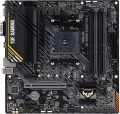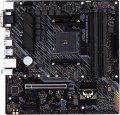Max. clock frequency
The maximum RAM clock speed supported by the motherboard. The actual clock frequency of the installed RAM modules should not exceed this indicator — otherwise, malfunctions are possible, and the capabilities of the “RAM” cannot be used to the fullest.
For modern PCs, a RAM frequency of
1500 – 2000 MHz or
less is considered very low,
2000 – 2500 MHz is modest,
2500 – 3000 MHz is average,
3000 – 3500 MHz is above average, and the most advanced boards can support frequencies of
3500 – 4000 MHz and even
more than 4000 MHz.
M.2 version
The version of the M.2 interface determines both the maximum data transfer rate and the supported devices that can be connected via physical M.2 connectors (see the corresponding paragraph).
The version of the M.2 interface in the specifications of motherboards is usually indicated by the number of connectors themselves and by the PCI-E revision provided for in each of them. For example, the entry “3x4.0” means three connectors capable of supporting PCI-E 4.0; and the designation “2x5.0, 1x4.0” means a trio of connectors, two of which support PCI-E 4.0, and another one supports PCI-E 5.0.
ARGB LED strip
Connector for connecting an addressable LED strip as a decorative lighting for a computer case. This type of "smart" tape is based on special LEDs, each of which consists of an LED light and a built-in controller, which allows you to flexibly control the luminosity using a special digital protocol and create amazing effects.
RGB LED strip
Connector for connecting a decorative LED strip and other devices with LED indication. Allows you to control the backlight of the case through the motherboard and customize the glow for your tasks, including synchronize it with other components.
DVI output
The motherboard has its own
DVI output; this clause also specifies the specific form of this interface.
Such an output is intended for transmitting video from an integrated graphics card (see above) or a processor with integrated graphics (we emphasize that it is impossible to output a signal from a discrete graphics card through the motherboard chipset). As for DVI specifically, this is a standard originally created for digital video devices, however, it also allows an analogue signal format, depending on the type. In modern computer technology, including motherboards, you can find two types of DVI:
— DVI-D. A standard that provides for the transmission of a signal only in digital form. Depending on the supported mode, the maximum resolution of such video can be 1920x1200 (single-link Single Link) or 2560x1600 (two-channel Dual Link); however, Single Link plugs can be connected to Dual Link ports, but not vice versa. Also note that such connectors are compatible with HDMI via adapters, while in some cases even sound transmission may be provided (although this function is not initially supported in DVI-D, and its availability should be specified separately).
— DVI-I. A standard that combines the DVI-D described above with analogue DVI-A and allows the signal to be output in both digital and analogue formats. DVI-A in its characteristics corresponds to VGA (see above): it supports resolutions up to 1280x1024
...inclusive and allows you to connect VGA screens through a simple adapter.DisplayPort
DisplayPort version
The version of the DisplayPort interface (see above) installed on the motherboard.
— v.1.2. The oldest version in use today (2010). It was in it that 3D support first appeared, the ability to work with the miniDisplayPort connector, as well as the option of connecting several screens in series to one port (daisy chain). The maximum resolution fully supported by v.1.2 is 5K at 30 fps, with some limitations, 8K video is also supported. And the v.1.2a update, introduced in 2013, added compatibility with the FreeSync technology used in AMD graphics cards.
— v.1.3. An update to the DisplayPort standard released in 2014. Thanks to the increase in bandwidth, it was possible to provide full support for 8K video (at 30 fps), and in 4K and 5K standards, increase the maximum frame rate to 120 and 60 fps, respectively. Another key update was the Dual-mode function, which provides compatibility with HDMI and DVI interfaces through the simplest passive adapters.
— v.1.4. The most recent version of the widely used. The bandwidth has been further increased (almost doubled compared to v.1.2, which allowed, albeit with some limitations, to transmit 4K and 5K video at up to 240 fps and 8K at up to 144 fps. In addition, Support for a number of special features has been added, including HDR10, and the maximum number of simultaneously transmitted audio channels has increased to 32.
USB 3.2 gen2
The number of native USB 3.2 gen2 connectors provided on the back of the motherboard. In this case, we mean traditional, full-size USB A ports.
USB 3.2 gen2(formerly known as USB 3.1 gen2 and simply USB 3.1) is the evolution of USB 3.2 after version 3.2 gen1 (see above). This standard provides connection speeds up to 10 Gbps, and to power external devices in such connectors, USB Power Delivery technology (see below) can be provided, which allows you to output up to 100 W per device (however, Power Delivery support is not mandatory, its presence should be specified separately). Traditionally for the USB standard, this interface is backwards compatible with previous versions — in other words, you can easily connect a device supporting USB 2.0 or 3.2 gen1 to this port (unless the speed will be limited by the capabilities of a slower version).
The more connectors provided in the design, the more peripheral devices can be connected to the motherboard without the use of additional equipment (USB splitters). In some models of motherboards, the number of ports of this type is
5 or even more. At the same time, we note that in addition to the connectors on the rear panel, connectors on the board itself (more precisely, ports on the case connected to such connectors) can also provide a USB connection. See below for more on this.
BIOS FlashBack
Motherboards that support
BIOS FlashBack provide the ability to flash or restore the BIOS without a processor, video card or memory. The main purpose of the function is to provide users with the ability to update the BIOS in cases where the current version is incompatible with the installed processor or other computer components, which may lead to the inability to start the system. As a rule, the motherboard provides for this a USB connector for a flash drive and a special button (usually labeled BIOS Flashback) - pressing it initiates the update process.
On a separate line, we note that the BIOS FlashBack function can be called differently depending on the manufacturer: in motherboards from ASRock and Asus - BIOS FlashBack, from Gigabyte - Q-Flash Plus, from MSI - Flash BIOS, etc.

